by Winding Pathways | Nov 22, 2018 | Garden/Yard, Geology/Weather, Nature
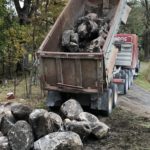
Glacial rocks arrive at Winding Pathways.
A modern glacier visited Winding Pathways in October.
Our area of Iowa doesn’t have much rock. There’s limestone bedrock in some places. Over the top is a thick layer of subsoil and topsoil with one exception. Glacial erratics.
Thousands of years ago the Upper Midwest was a cold world. Summers were so frigid that the previous winter’s snow didn’t melt. It packed down on top of previous winter’s snow and formed ice. Thick ice is fluid. It moves. Slowly. But it moves. Up in today’s Minnesota, glaciers scooped up granite and other rocks and gave each one a grand, if pokey, ride. As the ice inched forward, often southward, it carried rocks. Often they churned along the bottom of the ice, gradually rounding off like pebbles in the ocean surf do.
Fifteen or twenty thousand years ago the climate warmed. Ancient climate change. Instead of expanding, glaciers shrank, leaving their stone cargo in place, often hundreds of miles from where they were scooped from the ground.
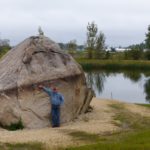
This massive erratic is the centerpiece of a new Marion, IA, park.
It’s complicated because there were several glacial periods of warming and cooling. Sometimes a new glacier picked up and moved rocks left by earlier ice sheets thousands of years earlier. The last glacier to visit Iowa melted about 12,000 years ago, leaving erratics here and there in the prairie that was converted to farm fields. Two of the most renowned glacial erratics in Eastern Iowa are Waldo’s Rock in Marion, and Bever Park’s boulder that generations of kids have climbed.
At Winding Pathways, we needed a retaining wall and first considered using manufactured concrete blocks. Then, we met Cody Rossman of Hardscapes. His business crafts glacial erratics into retaining walls. It’s not easy. Those hunks of rounded granite are heavy.
Cody’s crew brought truckloads of erratics to our yard from where the last glacier abandoned them near Troy Mills, Iowa. It took a husky truck about 45 minutes to bring the rocks 24 miles. That’s nearly 30 miles an hour.
It’s not certain how fast glaciers moved rocks, but it was slow. It could have taken years, decades, or even centuries for ice to move our rocks 24 miles. A speedy glacier might move a rock a mile a decade. Maybe a mile a century. Cody’s method was faster.
The wall’s in place. Every time we look at the rocks we wonder about their travel. Probably they originated in Minnesota hundreds of thousands of years ago to end up preventing erosion in our yard. What stories they could tell? Winding Pathways will find out in a few weeks when retired geologist, Ray Anderson visits and inspects the rocks and shares their stories.
Our wildlife also loves the rocks. A chpmunk popped up between two rocks as soon as the work crews left for the day. The uneven rock surfaces and the nooks and crannies between them provide safe living spaces for our chipmunks and garter snakes.
-
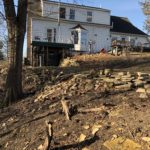
-
View of the old wall.
-
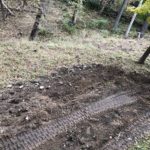
-
The old retaining wall material was removed first.
-
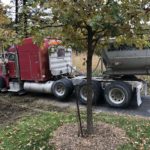
-
Glacial rocks arrive.
-
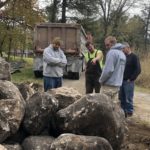
-
Sorting the rocks.
-
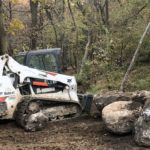
-
Bobcat moves rocks.
-
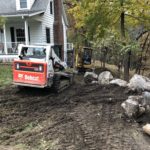
-
The rock wall takes shape.
-
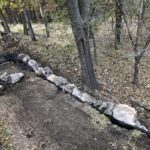
-
After excavating, geotextile is placed and glacial rocks arranged.
-

-
Hardscapes crew surveying the project.
-
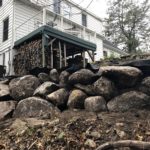
-
The rock wall is firmly in place.
-
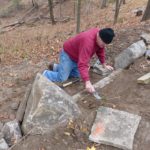
-
Limestone slabs are perfect for making steps.
-
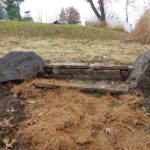
-
Milestone steps into the natural area.
-
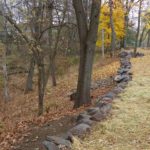
-
Straw protects grass seed and soil from eroding.
by Winding Pathways | Nov 15, 2018 | (Sub)Urban Homesteading, Bugs, Flowers/Grasses, Garden/Yard, Garden/Yard, Nature
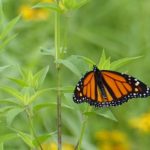
Butterfly on plant
This past summer we enjoyed watching many monarch butterflies flutter over our prairie labyrinth. Numbers were way up from last year.
These intrepid insects are now en route to wintering grounds in Mexico. We look forward to their return next year.
Monarchs suffered huge population declines due to varied stresses on their lives. In farm country, most fencerows, waterways, and pastures that once harbored milkweed and wildflowers that provided both caterpillars and adults with food have disappeared. Today’s farmland is a pesticide-laced monoculture of just a few crops.
In town, manicured and sprayed lawns are as devoid of diversity as a cornfield and can’t sustain beautiful wildlife like butterflies.
The news would be more distressing had people not responded with enthusiasm to the monarchs’ decline. This summer we were delighted to see dozens of homeowners in Cedar Rapids and other towns let their lawns grow taller. Many planted pollinator patches in even tiny yards that include a diversity of native plants, including milkweeds. We took joy in seeing a small patch of milkweeds nurtured by the staff of a convenience store in a tiny patch of dirt near the gas pumps.
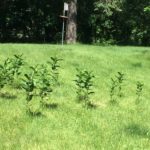
Grow a wild patch on your lawn to encourage butterflies.
Every pollinator patch, even if tiny, adds beauty and diversity to our world. We urge everyone to assist wildlife by creating natural plantings, even in urban areas.
Many Iowans have been inspired by the Monarch Zones Project. Founded by Clark McLeod, the Project provides workshops, encouragement, equipment, and seeds to help people assist this beautiful insect and hundreds of other beneficial species that add richness to our lives and health to the environment.
Next spring’s planting season isn’t far off. Now’s a fine time to plan to expand or create a pollinator patch in the yard. For help contact Monarch Research Project. Let’s continue to work together to create wondrous yards.
Bon voyage, Monarchs!
by Winding Pathways | Nov 1, 2018 | (Sub)Urban Homesteading, Garden/Yard
Chips flew from a white oak limb as our son-in-law, Brian Ohlen, masterfully wielded a cordless chainsaw. He and our daughter, Nancy, were visiting from their Alaskan home. Because Brian is a veteran chainsaw operator and former logger, we wanted his opinion on the EGO cordless chainsaw we recently acquired.
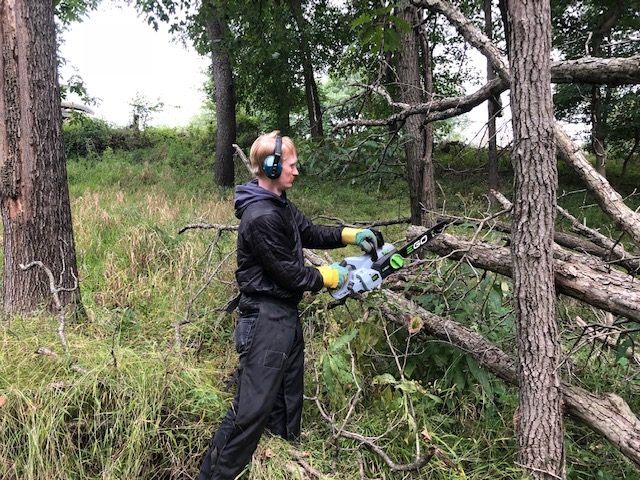
Brain Ohlen found the EGO Chain Saw to be efficient and lightweight.
The tree provided a great test. White oak is one of the best firewoods, but it’s a hard, tough wood that tests a saw. An extreme April windstorm snapped our tree off about twenty feet above the ground. Its massive top landed close to our barn. We were saddened to lose the magnificent oak that had spent a century converting Iowa’s sunlight into wood, but its death meant that we could, in turn, convert that solar energy into heat in our woodstove.
Brian kept running the saw as chips flew and piece after piece of firewood-sized wood dropped from thick limbs. After the battery finally was depleted and we took a break while it recharged, Brain remarked, “This saw is amazing. It’s lightweight and quiet and it cuts swiftly.” He looked the saw over and added, “I was surprised at how long the battery lasted.”
Rich also is an accomplished chainsaw operator who logged for the US Forest Service one summer in Idaho. Like Brian, he is amazed at the efficiency and ease of use of the EGO saw.
Cordless, battery-operated carpentry tools emerged on the market a couple of decades ago and today are valued by craftsmen and women for their power, ease of use, and efficiency. More recently, battery fueled chainsaws entered the market. The key to their value is the ability of lithium-ion batteries to store an enormous amount of energy.
The EGO saw is highly user-friendly It eliminates the need for gasoline and runs without the smelly exhaust of a gas saw. It’s lightweight and runs much quieter than a gasoline counterpart. Like gas saws, it requires bar oil to lubricate the chain and occasional sharpening. Unlike most gas saws EGO has crafted the saw to be user-friendly. For example, no tools are needed to open and close the sprocket housing or tighten the chain. This makes use a snap and saves time and the need to cart around a bar tool.
When I asked Brian’s opinion of the saw he responded, “This is an excellent saw for a homeowner who needs to cut dead branches and trim trees. It’s also a fast firewood cutter.”
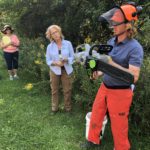
Protective gear keeps workers safer.
There is an important similarity shared by all chainsaws. They are powerful tools that must be used with respect and caution to prevent injury. When running any chainsaw wear eye, ear, and face protection, long pants, sturdy leather gloves and boots, and saw chaps. Saw chaps clip over pants and are designed to instantly stop a cutting chain that touches it. Chaps prevent serious injury to the thigh.
The EGO chainsaw is a dandy tool useful around the home. The battery that runs it also powers many other EGO tools, making a cordless tool system practical.
by Winding Pathways | Oct 25, 2018 | (Sub)Urban Homesteading, Flowers/Grasses, Garden/Yard, Garden/Yard, Nature, Reflections/Profiles
“It was amazing! Gorgeous! Fireflies danced over our prairie most of the summer, and they weren’t here when it was a mowed lawn,” said Katie Hill with much enthusiasm
She and her husband Tim are restoring an island of ecological health just three miles from downtown Cedar Rapids, Iowa. First Avenue is one of the busiest urban streets in Iowa, constantly filled with cars, motorcycles, and trucks. A bald eagle flying over the road would look down at an urbanized landscape – except for five acres of verdant beauty just a few feet east of the Avenue. The oasis is nestled between suburban developments, a high-rise condominium, and a senior residence complex.
Katie and Tim bought three and a half acres and a home about 15 years ago. It was convenient to his work at a law office a stone’s throw from their land. “We did the standard expected landscaping of mowing and spraying for about a decade,” she said.
Creating Habitat
Although the yard was large it lacked plant diversity and wildlife. Then came the change.
“We stopped spraying and I took delight when creeping Charlie and dandelions took hold. Many people don’t like them, but creeping Charlie has a gorgeous flower that bumblebees love, and it smells nice. Dandelions are beautiful, and bees love them,” she said. Then she broadcast prairie seed on a low area that had been lawn. After a couple of years big bluestem, Indian grass, and many native flowers appeared. Encouraged by their first prairie the Hill’s planted new ones in formerly mowed and sprayed lawns. They’ve been helped by David Novak, owner of a small company that helps people restore natural areas.
“We were delighted when lightning bugs appeared over the prairie. They don’t like mowed lawn but love taller plants. We watch them dance on summer evenings. These beautiful insects completely avoid the mowed lawns of our neighbors,” Tim and Katie remarked.
Early in 2018, the Hills bought about an acre and a half of land adjoining their property Years before several houses stood on the property but it had been purchased by a developer who planned to build two condominium towers. He razed the houses and built one condo tower but abandoned plans to build the second.
Restoring the Land
As we walked through the area Katie showed us her new prairie plantings in what had once been a lawn while Tim pointed out where the houses had stood. As the years go by the residents of the existing condominium tower will gaze downward during the day on wildflowers dancing in the breeze and butterflies sipping nectar from prairie blooms. As twilight approaches, they’ll enjoy fireflies blinking their tiny lights.
In addition to creating beauty and feeling the joy of making the earth healthier, the Hills are benefiting the community beyond their property. Prairie grasses absorb stormwater that once sheeted off their land and into storm sewers and eventually Cedar Lake. Their land nurtures wildlife as its beauty increases and diversifies.
“We feel good about what we are doing. We are helping nature restore itself in the heart of the city, but it also does one other thing. When we were mowing and spraying it was costing us about $600 a month to maintain the property. Now that’s dropped to about 90 bucks, so we’re saving money,” the Hills explained.
In the process of restoring their land, Tim and Katie Hill are also getting a fulfilling ecological education.
Win! Win! Win!
“It’s a win, win, win,” smiled Katie. “It’s a win for us saving money. It’s a win for us to have the time to be entertained by the wildlife diversity. And, most importantly, it’s a win for Mother Nature.”
-
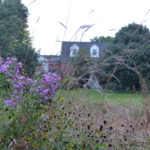
-
New England Asters grace the prairie.
-
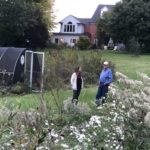
-
Butterflies have flocked to the Hill’s property.
-
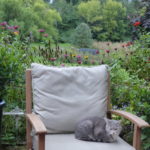
-
One of their many cats relaxes on the patio.
-
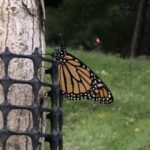
-
A Monarch perches in the lee of a tree resting before leaving for the south.
-
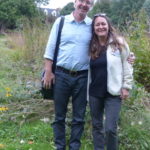
-
Owners of an urban oasis.
-
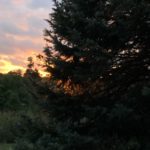
-
Beautiful sunset.
by Winding Pathways | Sep 20, 2018 | Chickens, Energy Efficiency, Flowers/Grasses, Garden/Yard, Garden/Yard, Nature
It’s turning time for wildlife, chickens, and people
As the Northern Hemisphere of the earth continues its ageless slow wobble away from the sun, days gradually shorten until a wondrous event happens.
The Autumnal Equinox happens around September 21st each year. It’s when daily hours of sunlight equal those of darkness. On only two days each year does every place on earth enjoy roughly 12 hours of sunshine. These are the fall and spring equinoxes. So, whether someone lives near the tropics or poles they will experience the same amount of light on only those two days.
Light changes quickly around equinox time. Up here in the Northern Hemisphere days shorten quickly and darkness advances until the December 21st Winter Solstice, the year’s darkest day. The Southern Hemisphere begins to enjoy its longest days through December.
Preparing
At Winding Pathways around the Equinox, we do these things:
- Stimulate our chickens. We plug in the timer and light bulb in the coop. Chickens lay the most eggs when there are about 15 hours of daylight. So, the coop light is set up to come on about 4:30 a.m. and turn off about three hours later when the sun pokes over the horizon.
- Drain, clean, and invert our rain barrels. We won’t need extra water until next spring, so we turn the barrels upside down, so they don’t collect winter water that freezes and can split the barrels. We weight them with stones to keep Arctic winds from blowing them away.
- Watch this short video on how to Prepare Rain Barrels
- Bring in pumpkins and winter squash. A frost is soon to come, and we don’t want it to bite our squash. We store
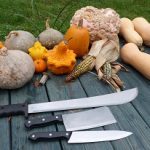
Winter Squash vary in color, texture, shape and size.
pumpkins and squash in a room we rarely use. It stays cool but above freezing. Butternut, Acorn, Hubbard, and most other winter squashes and pumpkins, which actually are a squash, keep for months and give us delicious and vitamin stoked food on cold days.
- Exclude, or try to, insects and mice. Somehow mice, box elder bugs and Asian beetles sense coming cold and find tiny cracks to enter the house and enjoy winter warmed by our furnace and wood stove. Each fall we caulk up cracks and weather strip doors to encourage them to stay outside where we prefer to see them. It’s never perfect. Some always find their way inside.
- Enjoy leaves. Each’s fall’s spectacular leaf color peaks in October but some leaves start turning sooner. Our backyard black walnut starts coloring up in early September. The real show is the deep orange, red, and yellows of our sugar maples. They peak in early to mid-October followed by russet oak leaves.
-
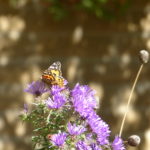
Fall wildflowers are an important food source for insects and birds.
Enjoy wildflowers. Asters, Goldenrods, and Maximilian Sunflowers are the very last blooms of the season. Their colors brighten the yard and provide nectar for insects and then seeds for migrating and overwintering birds. But all this comes with sadness as we know we’ll not see wildflowers again until next spring.
- Watch wildlife. It’s migration time and one of the best seasons for seeing unusual birds. We often look upward and sometimes spot pelicans and waterfowl winging high overhead. By now deer in their subdued winter coats are sleek and well fed on a diet of acorns. Bucks have polished their antlers. Chipmunks and squirrels scurry about caching winter food.
We’d like to hear what you enjoy about the Equinox time. Please email us your joys and projects in this wondrous season.
by Winding Pathways | Sep 18, 2018 | (Sub)Urban Homesteading, Chickens, Garden/Yard
Hoover’s Hatchery is sponsoring a “Chicken Shaming” contest! Seriously! Join the fun for some good clean Chicken Shaming by sending your story and photo. Winding Pathways works closely with Hoover’s Hatchery and we love their work.
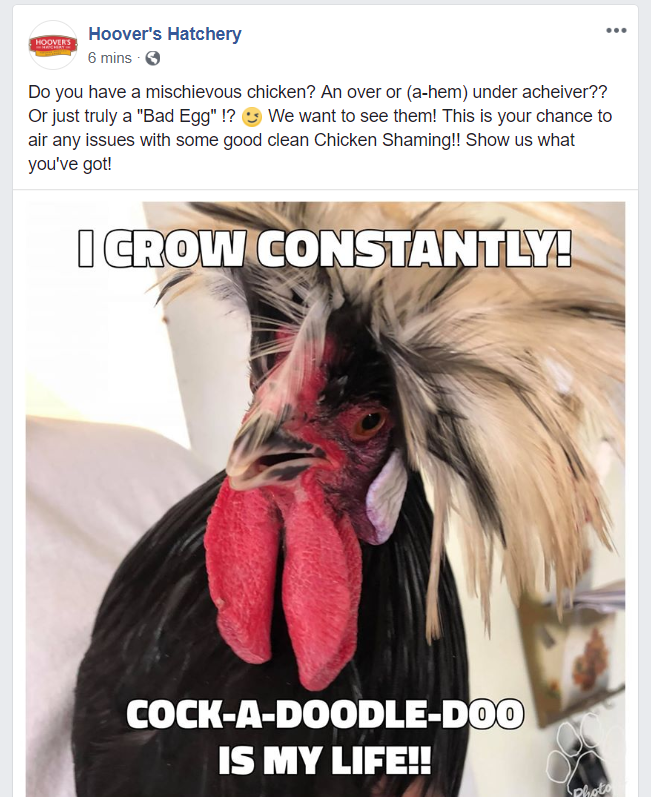
Hoovers Hatchery Invitation



























